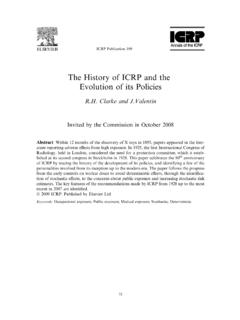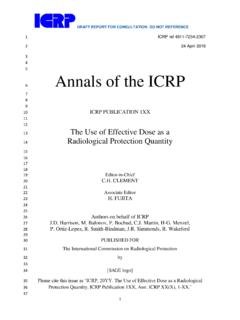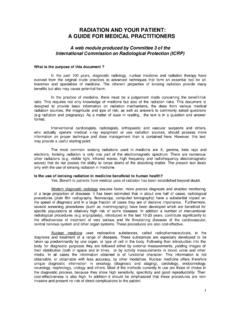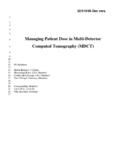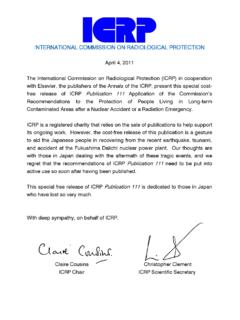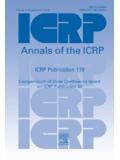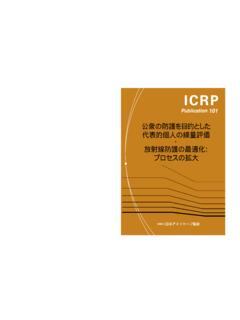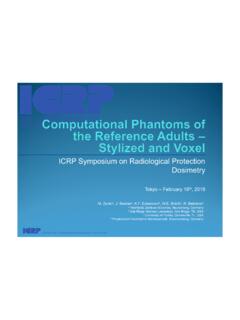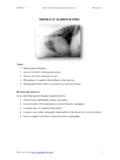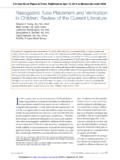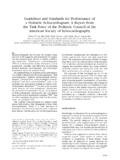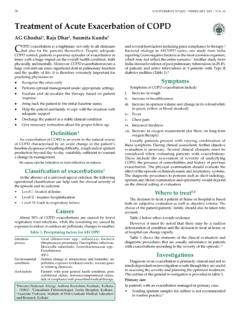Transcription of DIAGNOSTIC REFERENCE LEVELS IN MEDICAL IMAGING: …
1 1 DIAGNOSTIC REFERENCE LEVELS IN MEDICAL IMAGING: REVIEW AND ADDITIONAL ADVICE A web module produced by Committee 3 of the International Commission on Radiological Protection (ICRP Key Points DIAGNOSTIC REFERENCE LEVELS (DRLs) should be used by regional, national and local authorized bodies. The numerical values of DRLs are advisory, however, implementation of the DRL concept may be required by an authorized body. The concept of DRLs allows flexibility in their selection and implementation. The Committee 3 advice does not specify quantities, numerical values or details of implementation for DRLs. This is the task of the regional, national and local authorized bodies, each of which should meet the needs in its respective area. The Committee 3 rationale for its advice is that any reasonable and practical approach, consistent with the advice, will improve the management of patient doses in MEDICAL imaging. Introduction (1) The purpose of this document is to provide additional advice to regional, national and local authorized bodies and the clinical community on the application of DIAGNOSTIC REFERENCE LEVELS as a practical tool in DIAGNOSTIC radiology and nuclear medicine.)
2 Achieving acceptable image quality or adequate DIAGNOSTIC information, consistent with the MEDICAL imaging task, is the overriding clinical objective. DIAGNOSTIC REFERENCE LEVELS are then used to help manage the radiation dose to patients so that the dose is commensurate with the clinical purpose. (2) A review was conducted of the various approaches that have been taken by authorized bodies, working in concert with professional MEDICAL groups, to establish DIAGNOSTIC REFERENCE LEVELS for MEDICAL imaging tasks. While the approaches are not uniform in aim and methodology, it is concluded that there are a variety of ways to implement the concept of DIAGNOSTIC REFERENCE LEVELS , depending on the MEDICAL imaging task of interest, the regional, national or local state of practice, and the regional, national or local preferences for technical implementation. (3) The document briefly reviews the existing ICRP guidance, summarizes the information on approaches taken to date, and presents additional advice from ICRP Committee 3.
3 The advice given here provides a framework for DIAGNOSTIC REFERENCE LEVELS that is consistent with earlier ICRP guidance, but allows more flexibility in their selection 2 and use. While some illustrative examples are given, the advice does not specify the quantities to be used, the numerical values to be set for the quantities, or the technical details of how regional, national or local authorized bodies should implement DIAGNOSTIC REFERENCE LEVELS . Existing ICRP Guidance (4) ICRP Publication 60 (ICRP, 1991) provided the following recommendation in the section on optimization of protection in MEDICAL exposure in paragraph (S34): Consideration should be given to the use of dose constraints, or investigation LEVELS , selected by the appropriate professional or regulatory agency, for application in some common DIAGNOSTIC procedures. They should be applied with flexibility to allow higher doses where indicated by sound clinical judgment.
4 (5) ICRP Publication 73 (ICRP, 1996) introduced the term DIAGNOSTIC REFERENCE level, explained its place in the broader ICRP concept of REFERENCE LEVELS , and expanded the ICRP Publication 60 recommendation in (S34) in more detail [paragraphs (99) through (106) of ICRP Publication 73]. The main points are summarized below. (a) The term used is DIAGNOSTIC REFERENCE level. (b) The purpose is advisory. It is a form of investigation level to identify unusually high LEVELS , which calls for local review if consistently exceeded. In principle, there could be a lower level also ( below which there is insufficient radiation dose to achieve a suitable MEDICAL image). DIAGNOSTIC REFERENCE LEVELS are not for regulatory or commercial purposes, not a dose constraint, and not linked to limits or constraints. (c) The examination types include DIAGNOSTIC radiology and nuclear medicine ( common exams and broadly defined types of equipment). (d) Their selection is by professional MEDICAL bodies, using a percentile point on the observed distribution for patients, and specific to a country or region.
5 (e) The quantities should be easily measured, such as absorbed dose in air or tissue-equivalent material at the surface of a simple standard phantom or representative patient for DIAGNOSTIC radiology, and administered activity for DIAGNOSTIC nuclear medicine. Review of REFERENCE LEVELS in MEDICAL Imaging (6) There have been a number of approaches to REFERENCE LEVELS used for MEDICAL imaging. Typically, REFERENCE LEVELS are used as investigation LEVELS ( a quality assurance tool) and they are advisory. But, there are exceptions where the approach uses achievable LEVELS indicative of more optimum conditions, mentions dose constraints, or incorporates a dose limit or suspension level ( only for mammography used for screening). To clarify paragraph (5) (b), the numerical value of a DIAGNOSTIC REFERENCE level is advisory ( the numerical value is not for regulatory or commercial purposes, not a dose constraint, and not linked to limits or constraints).
6 However, authorized bodies may require implementation of the concept of a DIAGNOSTIC REFERENCE level. 3 (7) There have been fairly consistent criteria for selecting REFERENCE LEVELS , although the criteria used to date differ for DIAGNOSTIC radiology and nuclear medicine. In DIAGNOSTIC radiology, REFERENCE LEVELS usually have been derived from distributions of dosimetric quantities for patients observed in practice in the relevant region or country. Usually, only upper LEVELS have been selected and lower LEVELS have not been specified. In nuclear medicine, REFERENCE LEVELS usually have been derived from pragmatic values of administered activity based on accepted custom and practice. Typically, all REFERENCE LEVELS are developed through cooperation between radiation protection authorities and professional groups or specialists ( clinical peer involvement). (8) There have been different aims for various REFERENCE LEVELS . While REFERENCE LEVELS apply to a selected MEDICAL imaging task, often the clinical and technical conditions are not fully defined, with the degree of definition dependent on the aim.
7 At least three general aims can be identified: (a) To improve a regional, national or local distribution observed for a general MEDICAL imaging task, by identifying and reducing the number of unjustified high or low values in the distribution; (b) To promote good practice for a more specific MEDICAL imaging task; and (c) To promote an optimum range of values for a specified MEDICAL imaging protocol. (9) There have been a number of different quantities used for REFERENCE LEVELS . The quantity selected is dependent on the type of clinical procedure, for example, whether it is an individual radiographic projection, a procedure or examination consisting of multiple projections or field locations, or a DIAGNOSTIC nuclear medicine procedure ( a specific radiopharmaceutical and clinical purpose). The quantity used is also dependent on the body setting the REFERENCE level, and is related to the desired aim, local preference and the unique irradiation conditions.
8 (10) The observations given above highlight the array of considerations and approaches to REFERENCE LEVELS , whose features are displayed in Table 1 (Approaches to REFERENCE LEVELS ) and Table 2 (Listing of REFERENCE LEVELS ), which is a listing of approaches and values that have been selected by a number of authorized bodies in recent Tables 1 and 2 are for background information and are not part of the additional advice from Committee 3 given in paragraphs (12) through (23). _____ 1 There are continuing efforts to develop and implement DIAGNOSTIC REFERENCE LEVELS throughout the world. A recent IAEA/EC/PAHO/WHO Conference (IAEA, 2001) included a number of papers on these developments in DIAGNOSTIC radiology and nuclear medicine. 4 Underlying Considerations (11) In order to interpret correctly the relationship between a change in the numerical value of a quantity used as a DIAGNOSTIC REFERENCE level and the corresponding change in patient tissue doses that determine the relative patient risk, the following considerations are important: (a) The numerical value of the DIAGNOSTIC REFERENCE level should be tied to defined clinical and technical requirements for the MEDICAL imaging task.
9 A selected numerical value for one situation may not be applicable to different clinical and technical requirements, even if the same area of the body is being imaged. The requirements can be general or specific. (b) The relative tissue dose distribution in the body should not change appreciably among patients undergoing the selected MEDICAL imaging task. A proportional change in the measured quantity should correspond to a proportional and uniform percentage change in the individual tissue doses. If the relative tissue-dose distribution in the body is appreciably different from that used to establish the DIAGNOSTIC REFERENCE level, due to a different field size, field location, beam quality or other technical factor that alters the internal dose distribution, then interpretation of a change in the measured quantity with regard to the change in tissue doses (and therefore the patient risk) would be ambiguous. In setting DIAGNOSTIC REFERENCE LEVELS , regional, national and local authorized bodies and professional groups should be cognizant of these considerations.
10 Additional Advice on DIAGNOSTIC REFERENCE LEVELS from ICRP Committee 3 Objective of a DIAGNOSTIC REFERENCE Level (12) The objective of a DIAGNOSTIC REFERENCE level is to help avoid radiation dose to the patient that does not contribute to the clinical purpose of a MEDICAL imaging task. This is accomplished by comparison between the numerical value of the DIAGNOSTIC REFERENCE level (derived from relevant regional, national or local data) and the mean or other appropriate value observed in practice for a suitable REFERENCE group of patients or a suitable REFERENCE phantom. A REFERENCE group of patients is usually defined within a certain range of physical parameters ( height, weight). If an unselected sample of patients were used as a REFERENCE group, it would be difficult to interpret whether the observed value for the sample is higher or lower than the DIAGNOSTIC REFERENCE level. A DIAGNOSTIC REFERENCE level is not applied to individual patients.
